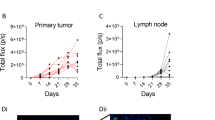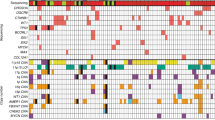Abstract
Adequate tumour models are a prerequisite in experimental cancer research. The purpose of the present work was to establish and assess the validity of four new orthotopic human melanoma xenograft model systems (A-07, D-12, R-18, U-25). Permanent cell lines were established in monolayer culture from subcutaneous metastases of four different melanoma patients by using an in vivo-in vitro procedure, and cells from these lines were inoculated intradermally in Balb/c nu/nu mice to form tumours. Individual xenografted tumours of the same line differed substantially in growth and pathophysiological parameters, probably as a consequence of differences between inoculation sites in host factors which influence tumour angiogenesis. Nevertheless, xenografted tumours of different lines showed distinctly different biological characteristics. Several biological characteristics of the donor patients' tumours were retained in the xenografted tumours, including angiogenic potential; growth, histopathological and pathophysiological parameters; and sensitivity to radiation, heat and dacarbazine treatment. Moreover, the organ-specific metastatic pattern of the xenografted tumours reflected the pattern of distant metastases in the donor patients. The organs of preference for distant metastases were lungs (A-07, D-12), lymph nodes (R-18) and brain (U-25). R-18 lymph node metastases and U-25 brain metastases developed in the absence of lung involvement. The four orthotopic human melanoma xenograft model systems show great promise for future studies of tumour angiogenesis, pathophysiology, treatment sensitivity and metastatic pattern.
This is a preview of subscription content, access via your institution
Access options
Subscribe to this journal
Receive 24 print issues and online access
$259.00 per year
only $10.79 per issue
Buy this article
- Purchase on Springer Link
- Instant access to full article PDF
Prices may be subject to local taxes which are calculated during checkout
Similar content being viewed by others
Author information
Authors and Affiliations
Rights and permissions
About this article
Cite this article
Rofstad, E. Orthotopic human melanoma xenograft model systems for studies of tumour angiogenesis, pathophysiology, treatment sensitivity and metastatic pattern. Br J Cancer 70, 804–812 (1994). https://doi.org/10.1038/bjc.1994.403
Issue Date:
DOI: https://doi.org/10.1038/bjc.1994.403
This article is cited by
-
Bevacizumab treatment of meningeal melanoma metastases
Journal of Translational Medicine (2020)
-
Vascular abnormalities and development of hypoxia in microscopic melanoma xenografts
Journal of Translational Medicine (2017)
-
Antiangiogenic agents targeting different angiogenic pathways have opposite effects on tumor hypoxia in R-18 human melanoma xenografts
BMC Cancer (2017)
-
Intertumor heterogeneity in vascularity and invasiveness of artificial melanoma brain metastases
Journal of Experimental & Clinical Cancer Research (2015)
-
Early effects of low dose bevacizumab treatment assessed by magnetic resonance imaging
BMC Cancer (2015)



